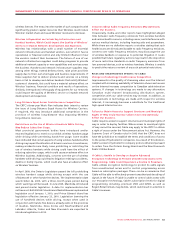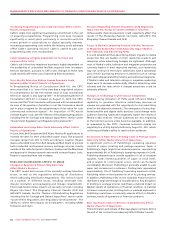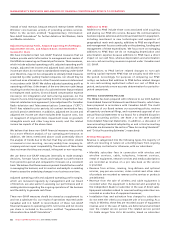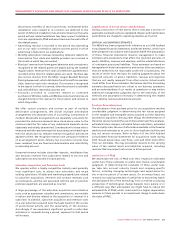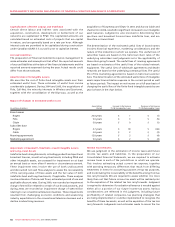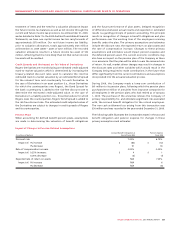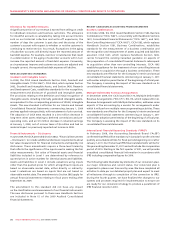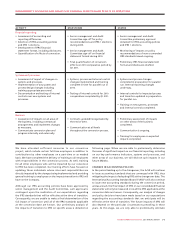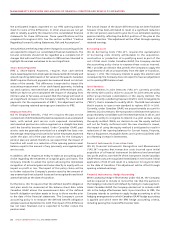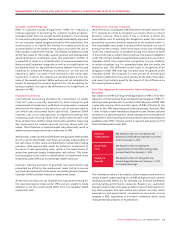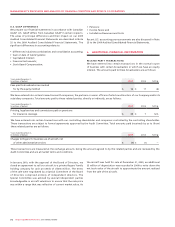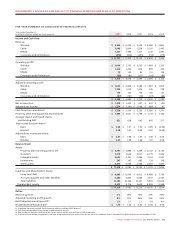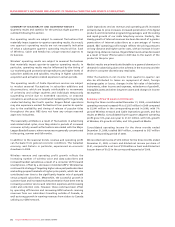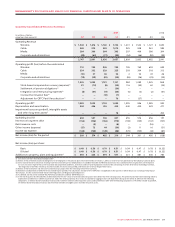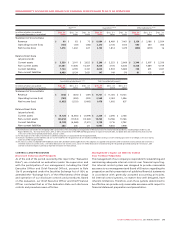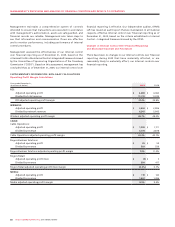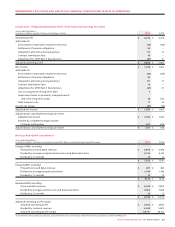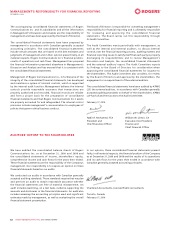Rogers 2009 Annual Report Download - page 68
Download and view the complete annual report
Please find page 68 of the 2009 Rogers annual report below. You can navigate through the pages in the report by either clicking on the pages listed below, or by using the keyword search tool below to find specific information within the annual report.
72 ROGERS COMMUNICATIONS INC. 2009 ANNUAL REPORT
MANAGEMENT’S DISCUSSION AND ANALYSIS OF FINANCIAL CONDITION AND RESULTS OF OPERATIONS
The overall impact of the above differences has not been finalized
however it has been estimated to result in a significant reduction
in the net pension asset and to give rise to an estimated opening
pension liability reflecting the deficit position of the plan at the
date of transition. This adjustment will be offset through opening
retained earnings.
Borrowing Costs
IAS 23, Borrowing Costs (“IAS 23”), requires the capitalization
of borrowing costs directly attributable to the acquisition,
construction or production of a qualifying asset as part of the
cost of that asset. Under Canadian GAAP, the Company elected
the accounting policy choice to expense these costs as incurred.
IFRS 1 provides an election that permits the Company to apply the
requirements of IAS 23 prospectively from the date of transition,
January 1, 2010. The Company intends to apply this election and
consequently, the Company does not expect to have an adjustment
on its opening IFRS balance sheet.
Joint Ventures
IAS 31, Interests in Joint Ventures (“IAS 31”) currently provides
the entity with a policy choice to account for joint ventures using
either proportionate consolidation or the equity method. The
IASB is currently considering Exposure Draft 9, Joint Arrangements
(“ED 9”), that is intended to modify IAS 31. The IASB has indicated
that it expects to issue a new standard to replace IAS 31 in 2010.
Currently, under Canadian GAAP, we proportionately account for
interests in joint ventures. ED 9 proposes to eliminate the option to
proportionately consolidate such interests that exists in IAS 31, and
require an entity to recognize its interest in a joint venture, using
the equity method. While our decision to use the equity method
will not be finally confirmed until the new standard is issued,
the impact of using the equity method is anticipated to result in
reductions of the opening balances for Current Assets, Property,
Plant & Equipment, Intangible Assets and Current Liabilities with
an offsetting increase in Investments.
Financial Instruments: Transaction Costs
IAS 39, Financial Instruments: Recognition and Measurement
(“IAS 39”) requires that transaction costs incurred upon initial
acquisition of a financial instrument be deferred and amortized
into profit and loss over the life of the instrument. Under Canadian
GAAP these costs are recognized immediately in net income. Initial
application of IAS 39 will result in a reduction in long-term debt
on the date of transition. This adjustment will be offset through
opening retained earnings.
Financial Instruments: Hedge Accounting
When assessing hedge effectiveness under IAS 39, the Company
will be required to include in its test the risk that the parties to
the hedging instrument will default by failing to make payment.
Under Canadian GAAP, the Company elected not to include credit
risk in the hedge effectiveness tests. Upon transition to IFRS, the
Company intends to continue to apply hedge accounting to all its
hedging arrangements to which Canadian GAAP hedge accounting
is applied and which meet the IFRS hedge accounting criteria,
including passing the revised effectiveness tests.
the anticipated impacts expected on our IFRS opening balance
sheet for some of the differences. In other areas we are not yet
able to reliably quantify the impacts to the consolidated financial
statements for these differences. These quantifications will be
completed throughout 2010. See the section entitled “Caution
Regarding Forward-Looking Statements, Risk and Assumptions”.
Set out below are the key areas where changes in accounting policies
are expected to impact our consolidated financial statements. The
list and comments should not be regarded as a complete list of
changes that will result from transition to IFRS and are intended to
highlight those areas we believe to be most significant.
Share-Based Payments
IFRS 2, Share-Based Payments, requires that cash-settled
share-based payments to employees be measured (both initially and
at each reporting date) based on fair values of the awards. Canadian
GAAP requires that such payments be measured based on intrinsic
values of the awards. This difference is expected to impact the
accounting measurement of our stock-based payments, including
our stock options, restricted share units and deferred share units.
While we have not yet recalculated the impact of changing from
intrinsic value to fair value, we expect that the change will result in
an insignificant increase in the Company’s liability for share based
payments. Per the requirements of IFRS 1, this adjustment will be
offset in opening retained earnings upon transition to IFRS.
Employee Benefits
IAS 19, Employee Benefits, (“IAS 19”) requires the past service
cost element of defined benefit plans be expensed on an accelerated
basis, with vested past service costs expensed immediately
and unvested past service costs recognized on a straight-line basis
until the benefits become vested. Under Canadian GAAP, past
service costs are generally amortized on a straight-line basis over
the average remaining service period of active employees expected
under the plan. All of the past service costs for the Company’s
pension plan are vested; therefore, we expect that the impact of
transition will result in a reduction of the opening pension asset
balance equal to the amount of any previously unrecognized past
service costs.
In addition, IAS 19 requires an entity to make an accounting policy
choice regarding the treatment of actuarial gains and losses. The
Company intends to adopt the option allowing the immediate
recognition of actuarial gains and losses directly in equity with no
impact on profit or loss. The impact of this policy choice will be
to further reduce the Company’s pension asset by the amount of
any unamortized net actuarial losses and unrecognized transitional
assets that exist at the date of transition.
Furthermore, IAS 19 requires that the defined benefit obligation
and plan assets be measured at the balance sheet date while
Canadian GAAP allows the measurement date of the defined
benefit obligation and plan assets to be up to three months prior
to the date of the financial statements. The Company’s current
accounting policy is to measure the defined benefit obligation
and plan assets at September 30, 2009. The impact of this difference
has not been finalized, but is expected to further reduce the
pension asset.



